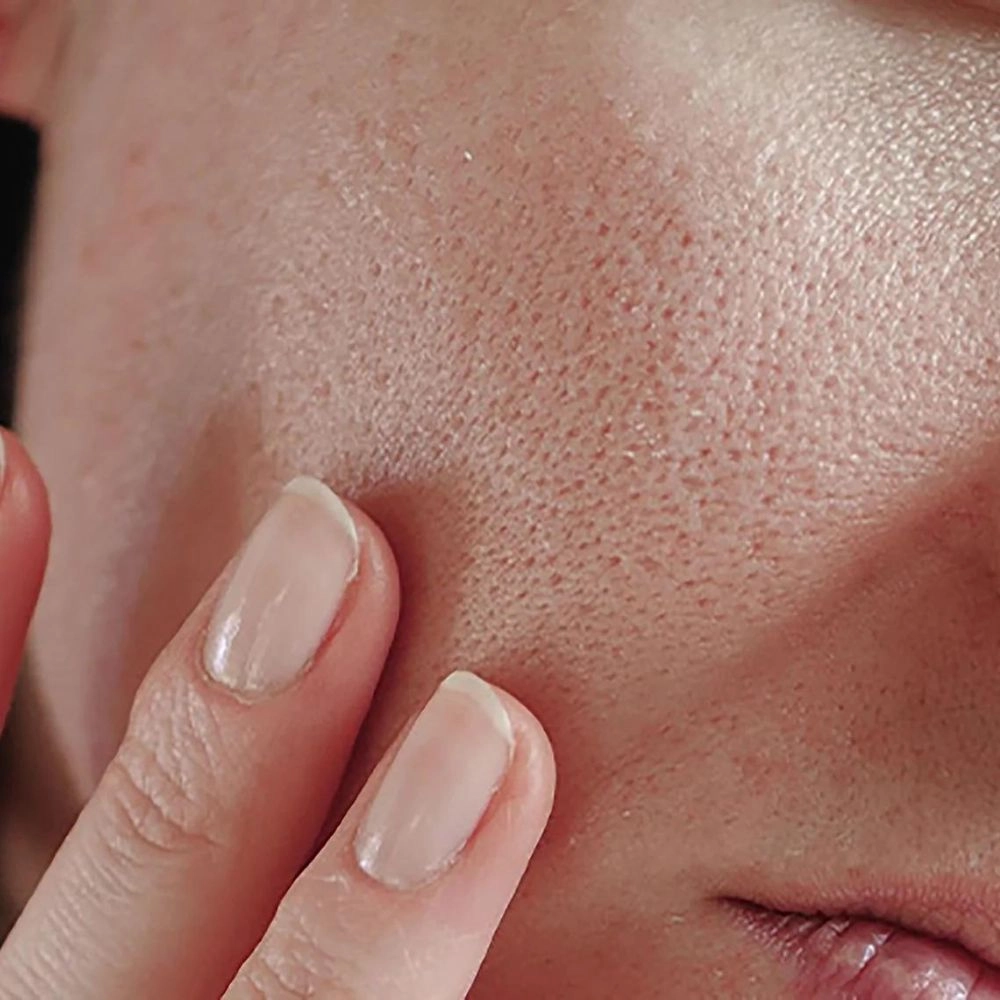Table of content
- Types of BREAST RECONSTRUCTION
- Procedure
- Risks and complications
- Pre-operation preparation
- Post-operative care
- Expected Results and recovery timeline
- Appointments and consultation
- Frequently asked questions
- Meet the team
- Pricing and payment plans
- Medical literature and research
- Support and counseling
- Send a message
WIDE PORES
INDICATION – BRIEF
Enlarged pores or “wide pores” is a common skin issue caused by factors such as excessive sebum production, decreased skin elasticity due to aging or sun damage, genetic predisposition, acne, and inflammation. Non-clinical causes include prolonged sun exposure, poor skincare routine, adverse lifestyle and environmental factors like smoking and pollution, incorrect makeup usage, and skin dehydration. Management of this condition usually involves addressing the underlying cause, maintaining a proper skincare regimen including regular cleansing and exfoliating, and using non-comedogenic products. Dermatological procedures such as chemical peels, laser resurfacing, or retinoid creams might be recommended in some cases.

INDICATION – DEFINITION
“Wide pores” or enlarged pores is a common skin condition that can affect people of all ages, although it often becomes more noticeable with aging. It is most prevalent in people with oily or combination skin. Here’s a brief overview of this condition, including both clinical and non-clinical causes.
Clinical Factors
- Sebum production: Pores appear larger when they’re clogged with dirt, oil, and dead skin cells. An excess amount of sebum, which is the oily substance produced by your skin’s sebaceous glands, is often a major contributor to this.
- Decreased skin elasticity: As we age, our skin’s elasticity diminishes due to decreased collagen production, causing pores to dilate and appear larger. The cumulative sun damage over the years accelerates this process.
- Acne and inflammation: Inflammatory skin conditions like acne can lead to the widening of pores. The inflammation and subsequent healing process can stretch the pores, causing them to appear larger than normal.
- Genetics: If your family members have large pores, there’s a likelihood you may inherit that trait.
Non-clinical factors
- Sun exposure: Over time, harmful sun rays break down the collagen and elastin that support the skin’s surface, causing it to sag and making pores look bigger.
- Poor skincare routine: Inadequate cleansing of the skin can lead to the buildup of oil and dead skin cells, leading to enlarged pores. Also, using harsh products can strip the skin of its natural oils, causing overproduction of oil and thus larger pores.
- Lifestyle and environmental factors: Smoking, pollution, high humidity, and a diet high in fats and unhealthy oils can exacerbate the problem of large pores.
- Incorrect makeup usage: Using comedogenic (pore-clogging) cosmetics and not properly removing makeup can cause an accumulation of debris, resulting in larger-looking pores.
- Dehydration: When the skin is not adequately hydrated, it can shrivel and cause pores to appear enlarged.
Treatment of enlarged pores usually involves addressing the underlying cause. Skincare routines that incorporate regular cleansing, exfoliating, and use of non-comedogenic products can help manage the condition. In some cases, dermatological procedures such as chemical peels, laser resurfacing, or retinoid creams may be recommended. It’s always best to consult with a professional for personalized advice and treatment plans.
SYMPTOMS AND DIAGNOSIS
Enlarged or wide pores generally appear on the skin as small pits, which might give your skin a dimpled, similar to an orange peel, appearance. Here are some symptoms and ways to diagnose this condition.
Symptoms
- Visible Pores: The most apparent symptom is visible pores. These tend to appear on the nose, forehead, and cheeks, where the skin is oilier.
- Oily Skin: Enlarged pores often go hand-in-hand with oily skin. The excess oil production leads to clogged pores, making them appear larger.
- Blemishes: Acne, blackheads, and other types of skin blemishes are also common in areas where the pores are large.
- Uneven Skin Texture: The skin may also appear rough or uneven due to the dilated pores.
Diagnosis
A diagnosis for enlarged pores is typically straightforward and based on a visual examination of the skin by a dermatologist. The skin is examined either with the naked eye or with a dermatoscope, a tool that provides magnification and lighting to evaluate the skin’s surface and structures.
During the examination, the dermatologist will look for the typical signs of enlarged pores such as visibly larger pores and uneven skin texture. They may also inquire about your skin care routine, lifestyle habits, and medical history to understand the possible causes and to guide the treatment plan.
Prognosis and Impact

The prognosis for wide pores is generally favorable, although it’s important to note that managing this condition is more about controlling it rather than eradicating it. While it’s impossible to permanently shrink pores to a size smaller than their natural state due to genetic factors, their appearance can be significantly reduced with the right treatment and skincare practices.
Prognosis
With regular and appropriate skincare, many people see an improvement in the appearance of their wide pores. This includes regular cleansing, use of non-comedogenic products, sun protection, and maintaining good hydration. For stubborn cases, dermatological treatments like chemical peels, retinoid creams, and laser resurfacing may provide more noticeable results. Consistency is key to maintaining these results over time.
Impact
Enlarged pores don’t typically cause physical discomfort or have direct health impacts, but they can significantly affect a person’s self-esteem and confidence due to the perceived impact on physical appearance. This can potentially lead to stress, social withdrawal, and in some cases, mental health concerns like anxiety and depression.
Additionally, individuals with wide pores often have a higher tendency to develop acne and blemishes due to excess oil and skin cell accumulation. This can require additional skincare measures or treatments to manage these secondary conditions.
Treatment Options
The management of wide pores typically involves a combination of skincare routine modifications, over-the-counter products, and professional treatments. Here are the primary strategies:
Skincare Routine Modifications
- Cleansing: Regular and thorough cleansing with a gentle, non-comedogenic cleanser helps remove excess oil and skin cell debris that can clog and enlarge pores.
- Exfoliation: Regular exfoliation with products containing alpha and beta hydroxy acids (like glycolic and salicylic acid) can help clear dead skin cells and reduce the appearance of wide pores.
- Moisturizing: Use a non-comedogenic moisturizer to maintain skin hydration without clogging pores.
- Sun Protection: Protecting the skin from sun damage helps maintain skin elasticity and prevent pore enlargement.
Over-the-Counter Products
- Retinol: Over-the-counter retinol products can promote cell turnover, reduce sebum production, and improve the appearance of wide pores.
Professional Treatments
- Topical Retinoids: Prescription-strength topical retinoids (like tretinoin) can effectively reduce sebum production and promote skin cell turnover.
- Chemical Peels: These treatments use a chemical solution to exfoliate the skin, which can help reduce the appearance of large pores.
- Microdermabrasion and Dermabrasion: These are exfoliating treatments that remove the outer layers of skin to improve its texture and appearance.
- Laser Treatments: Non-ablative laser treatments can help stimulate collagen production, improving skin texture and reducing the appearance of pores.
- Microneedling: This treatment creates tiny punctures in the skin to stimulate collagen production, improving skin texture.
- Topical Niacinamide: A form of vitamin B3, niacinamide can help to regulate sebum production and improve skin texture, thereby reducing the appearance of pores.
Remember, everyone’s skin is different, and the effectiveness of treatments can vary depending on individual factors. Consulting with a dermatologist will help determine the most appropriate treatment plan for your specific condition and skin type.
Risks and Side Effects
Skincare Routine Modifications
While generally safe, inappropriate use of skin care products may lead to dryness, irritation, and increased skin sensitivity. Over-exfoliation can strip the skin of its natural oils and damage the skin barrier, leading to dryness, redness, and increased susceptibility to sun damage.
Over-the-Counter Products
- Retinol: While generally well-tolerated, some individuals may experience skin irritation, dryness, and increased sensitivity to sun from retinol use.
Professional Treatments
- Topical Retinoids: Similar to over-the-counter retinol, prescription retinoids can cause skin irritation, dryness, and photosensitivity. They should not be used by pregnant or breastfeeding women due to potential risk to the baby.
- Chemical Peels: Side effects can include temporary redness, dryness, and mild irritation. In rare cases, it can cause changes in skin color, scarring, and infection.
- Microdermabrasion and Dermabrasion: These treatments can cause redness, dryness, and sensitivity. More intense treatments may lead to changes in skin color, scarring, or infection.
- Laser Treatments: Possible side effects include redness, swelling, and discomfort at the treatment site. Rarely, it can cause blistering, scarring, or changes in skin color.
- Microneedling: Side effects may include redness, swelling, and minor skin irritation. There’s also a risk of infection if not performed under sterile conditions.
- Topical Niacinamide: Generally well-tolerated, but some people may experience mild irritation or redness.
FAQ Section
Wide pores can be caused by various factors including excess sebum production, aging and reduced skin elasticity, acne and inflammation, and genetics. Non-clinical factors include prolonged sun exposure, poor skincare routines, adverse lifestyle and environmental factors, incorrect makeup usage, and skin dehydration.
While it’s not possible to permanently shrink pores to a size smaller than their genetic determination, it’s possible to reduce their appearance significantly with appropriate treatments and skincare routines.
Regular cleansing, exfoliating, and moisturizing using non-comedogenic products can help keep pores clean and minimize their appearance. It’s also important to use sun protection to prevent damage to your skin’s collagen and elastin, which can lead to enlarged pores.
Over-the-counter products containing ingredients like salicylic acid, glycolic acid, and retinol can help exfoliate the skin, reduce sebum production, and improve the appearance of wide pores. Always choose non-comedogenic products to prevent pore clogging.
Yes, various professional treatments like prescription-strength topical retinoids, chemical peels, microdermabrasion, laser treatments, and microneedling can help improve the appearance of wide pores. Always consult with a dermatologist to determine the most suitable treatment for your skin type and condition.
Side effects can vary based on the specific treatment, but may include skin irritation, dryness, increased sensitivity to sun, temporary redness, and swelling. More intense treatments could potentially lead to changes in skin color, scarring, or infection. Always consult with your dermatologist about potential side effects before starting a new treatment.
Improvement time can vary depending on the individual’s skin type, the severity of the condition, and the specific treatment method used. However, most people can expect to see some improvement in the appearance of their wide pores after several weeks of consistent and proper skincare.
